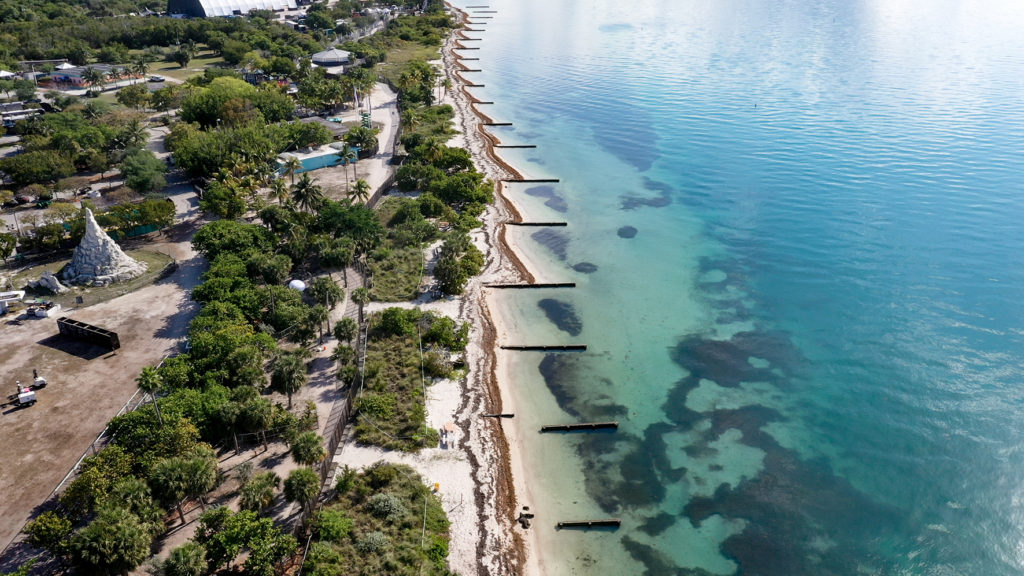Dying Bay: Biscayne Bay Seagrass Habitats Near Total Collapse
Rumya SundaramMay 27, 2019

In this image from a drone video, seagrass is seen off the beach of Virginia Key, March 2019 (Miami Waterkeeper via Key News)
A blockbuster report this past February concluded that in certain spots, up to 93 percent of Biscayne Bay’s seagrass is dead. The report was so grave that several groups, both inside and outside of government, are rapidly trying to come up with solutions.
The “Report on the Findings of the County’s Study on the Decline of Seagrass and Hardbottom Habitat in Biscayne Bay” outlines the current state of seagrass habitat and the changes it has incurred over the past several years.
Biscayne Bay has historically been an estuary where freshwater flows from the Florida mainland and then mixes with saltwater from the Atlantic Ocean. This creates a unique ecosystem consisting of mangrove, freshwater and saltwater marsh habitats. It is one of the reasons the federal government designated much of our waters as the nation’s only underwater National Park — Biscayne National Park.
The federal park is bordered by two state preserves to the north and south; they have been given the highest level of protection in Florida, a designation of “Outstanding Florida Waters.“
Despite all these protections, the bay ecosystem has suffered deterioration due predominantly to human activity.
In the past, Biscayne Bay got fresh water from a movement of water, known as “sheetflow,” which traveled from Kissimmee through Lake Okeechobee and into the Everglades, where it slowly filtered continuously through tributaries into Biscayne Bay and Florida Bay. This flow maintained good water quality necessary for marine life.
But over time, most of these natural tributaries have been dredged and channelized, and canals have been created that release water directly, mostly farther north, to prevent flooding in developed areas.
The County’s study said most bay freshwater is now from canal discharge rather than sheetflow. While the bay currently receives freshwater from canals (about 50 percent of freshwater), rain and groundwater sheetflow, the report does not mention that the overall total amount of freshwater is greatly reduced from historic levels, according to the National Park Service. Less freshwater means Biscayne Bay has become more saline, changing the ecosystem drastically.
Seagrasses have been particularly hard hit by changes in fresh water flow. They are a vital part of the ecosystem for a number of reasons. They provide habitat for many juvenile fishes, some of which are important fisheries species and some of which will later live in coral reefs. They also house stone crab, blue crab, shrimp and lobster. Aside from their function as home to many species, they offer important protection to the shoreline by stabilizing sediment and preventing erosion, which is an important consideration during hurricane season, as storm surges increase. Seagrasses are an important food source for many animals, such as manatees, and also take up nutrients and help maintain water quality and clarity.
Most importantly, according to the County’s report, the change in freshwater flow now means an excess of nutrients. In the past, as groundwater filtered through the Everglades’ tributaries, freshwater flowing into the bay would have extremely low nutrient levels, including phosphorus and nitrogen.
Now that the water has been channelized into canals, it flows directly from high-nutrient areas, such as agricultural land or leaking septic tanks, into the bay without the benefit of natural filtration. The seagrass has suffered as a result.
The canals account for 60 percent of phosphorus and 16 percent of nitrogen load into the bay. The increased nutrients cause turbidity, or cloudiness, in the water that prevents photosynthesis. This is also often linked to algal blooms. The high nutrient loads also reduce the water quality which seagrass needs to thrive. Algal blooms often create environments of anoxia, or lacking oxygen. This, in turn, affects the physiology of seagrass and causes animal species to leave the area or perish.
The County report found:
- The Julia Tuttle basin had reduced seagrass habitat by 77 percent and 79th Street Basin by 89.6 percent.
- Barnes Sound and Manatee Bay basins have had a decrease of 93 percent.
- Areas near Coral Gables experienced a decrease of about 85 percent.
- Areas north of the Rickenbacker Causeway decreased about 66-89 percent.
The Miami-Dade County Commission has ordered crash studies to get a better understanding of the problem and to find solutions. The County staff report suggested improving water quality and habitat monitoring programs and a bay habitat restoration program. But it also said “infrastructure improvements” would be needed to address some of the problems at the source.
EDITOR’S NOTE: The author is Citizen Scientist Coordinator for the Key Biscayne Community Foundation



Responses
Beau Williams
May 27
The collapse of Biscayne Bay Seagrass is alarming to scientist and environmental consultants like myself. I am not sure if blaming saline on why Turtle grass is dying is actually accurate. It has probably he highest tolerance for saline of any Seagrass. There hundreds of thousands of acres of Seagrass that have zero freshwater influence and are healthy. The cause is not known why the decline in Biscayne Bay, but I would be interested in who is saying it is excess saline that is killing the Seagrasses.
Jule
May 28
I’m sure man has something to do with this. Draining and dredging waterways and altering natural water flow I’m sure has a lot to do with this
John gomez
May 31
So…. When the grass dies. We’ll get white Sandy beaches?
The comments are closed.